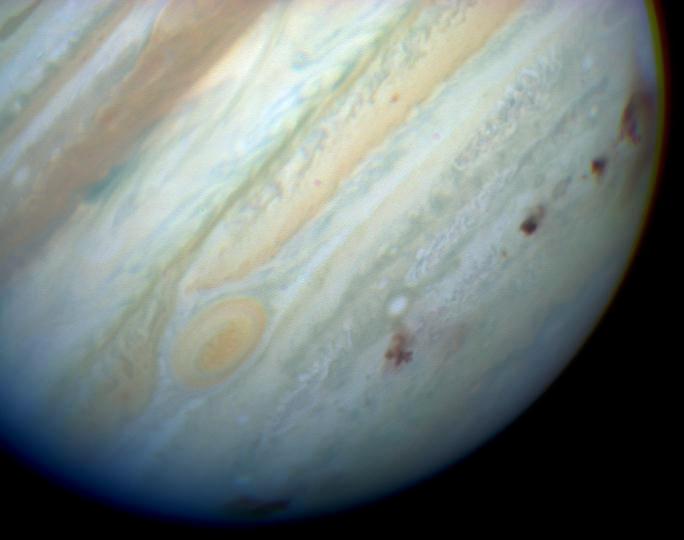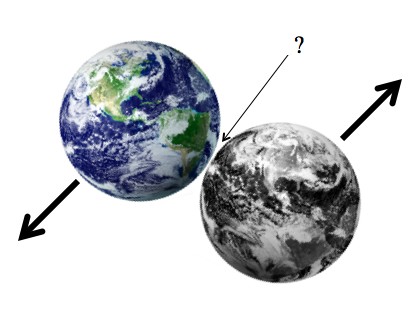Physicist: There’s a long history of big things in the solar system slamming into each other. Recently (the last 4.5 billion years or so) there haven’t been a lot of planetary collisions, but there are still lots of “minor” collisions like the Chicxulub asteroid 65 million years ago that caused that whole kerfuffle (65,000,000 years is practically this morning compared to the age of the solar system), or comet Shoemaker Levy 9 which uglied up Jupiter back in 1994.

Jupiter after a run-in with Shoemaker Levy 9. Each of those black clouds on the lower right is caused by the impact of a different chunk of the same comet, and each is bigger than Earth.
So while planets slamming or nearly slamming into each other isn’t a serious concern today, it was at one time. Of course, in solar systems where this is still a serious concern, there’s unlikely to be anything alive to do the concerning.
For the sake of this post, let’s say there’s another planet, “Htrae”, that is the same size and approximate composition of Earth (but possibly populated entirely with evil goatee-having doppelgangers with reversed names).
A direct impact, or even a glancing impact, is more or less what you might expect: you start with two planets and end with lots of hot dust. We’re used to impacts that dent or punch through the crust of the Earth, but really big impacts treat both planets like water droplets. Rather than crushing together like lumps of clay, Earth and Htrae would “splash” off of each other. A direct impact of two like-masses tends to destroy them both. A glancing, well-off-center, impact will “stir” both planets, leaving no none of the original surface on either. A glancing impact like this is the best modern theory of the origin of the Moon.
If Htrae were to fall out of the sky, it would probably hit the Earth with a speed that’s on the same scale as Earth’s escape velocity: 11 km/s (Probably more). The time between when Htrae appears to be about the same size as the Sun or Moon, to when it physically hits the surface, would be a couple of weeks (give or take a lot). The time between hitting the top of the atmosphere and hitting the bottom would be a few seconds. If you were around, you would see Htrae spanning from one horizon to the other. A few moments before impact the collective atmospheres of both planets would glow brightly as they are suddenly compressed. It’s more likely that in those last few seconds/moments you would be vaporized from a distance by the heat and light released by the impact, and less likely that you would be crushed. People on the far side of Earth wouldn’t fare much better. They’d get very little warning, and would have to suddenly deal with the ground, and everything on it, suddenly being given a kick from below big enough to go flying into space.
Generally speaking, being slapped by the ground so hard that you find yourself in deep space a few minutes later is seriously fatal.
A near miss is a lot less flashy, but you really wouldn’t want to be around for that either. When you’re between two equal masses, you’re pulled equally by both. You may be standing on the surface of Earth, but most of it is still a long way away (about 4,000 miles on average). So if Htrae’s surface was within spitting distance, then you’d be about 4,000 miles from most of it as well. Nothing on the surface of Earth has any special “Earth-gravity-solidarity”, so if you were “lucky” enough to be standing right under Htrae as it passed overhead, you’d find yourself in nearly zero gravity.
Of course, there’s nothing special about stuff that’s on the surface either. The surface itself would also start floating around, and the local atmosphere would certainly take the opportunity to wander off. On a large scale this is described by the planets being well within each others’ Roche limit, which means that they literally just kinda fall apart. It’s not just that the region between the planets is in free fall, it’s that halfway around the worlds gravity will suddenly be pointing sideways quite a bit. So, what does a land-slide the size of a planet look like? From a distance it’s likely to be amazing, but you’re gonna want that distance to be pretty big.
Even a near miss, with the planets never quite coming into contact, does a colossal amount of damage. There would be a cloud of debris between and orbiting around both planets (or rather around both “roiling molten masses”) as well as long streamers of what used to be ocean, crust, and mantle extending between them as they move apart. This has never been seen on a planetary scale, since all the things doing the impacting these days barely have their own gravity. The highest vertical leap on a comet would be infinity (if anyone were to try).
But the news gets worse. Unless both planets have a good reason to be really screaming past each other (maybe they were counter-orbiting or Htrae fell inward from the outer solar system or something), a near miss is usually just a preamble for a direct impact. All of the damage and scrambling that Earth and Htrae did do each other took energy. That energy is taken mostly from the kinetic energy, so after a near miss the average speed of the two planets would be less than it was before. And that means that the planets often can’t escape from each other (at least not forever). In fact, this is why Shoemaker Levy 9 impacted Jupiter a dozen times instead of all at once. Before impacting, the comet had passed within Jupiter’s Roche limit (probably several times), been pulled into a streamer of rocks, and slowed down.








Awesome post! I love reading these kinds of descriptions of really extreme events.
Which planet would undergo greater damage?
Hmmm…. A lot of the atmosphere would get sucked off. The moon would probably be destroyed even if the planets didn’t come in contact. The tides would be outrageously large. All kinds of effects.
@Joe
Same amount for both, if they start out more or less identical.
Thinking about the near miss case. Would we not see more of a tidal type effect? The two objects are in hyperbolic orbits around the center of mass. I see a big bulge towards each other, and a big bulge on the far sides. I am not quite seeing the big sideways forces part mid way back. Of course, with the planets rotating, the tidal bulge would move around quite a bit. What about the poles (assuming the interaction happens along the equatorial planes)?
You posted my question !!!!! 🙂 Nicely answered too, i see you added more intelligent comedy to the explanation than was in the email reply you sent me haha. Good Stuff
Pingback: Guerrilla Monkey – The Infinite Bookmarks Page
So what would it take to get some rocks “screaming past” venus or mars a couple of times and move them into earth’s orbit?
Actually, it would be like “WHOOOOOOO AAAAAAHHH!!!!! Close call, dude…”. Many people still think that the Sun has an unknown, unrecognized planet with an excentric orbit, that periodically shows up and unleashes havoc on Earth. Some people call it “Nibiru”, some pseudo scientists even dared to guess and declare an orbital period of some thousands of years for it, explaining with it our actual disconnection with ancient cultures. Could something like that be remotely possible?
I am researching (for the purpose of a hard sf novel I am working on) exactly what the consequences of a multiple asteroid or comet hit on Earth. Hmmm, just like Shoemaker Levy 9, but Earth as the target. Could anyone provide a link to a good edu or research article? Thanks!
This is really amazing!!
Fascinating.
So what is the farthest away a runaway planet of similar size to earth can actually pass earth without spelling doom for the earth (wouldn’t mess up our orbit, wouldn’t mess up our atmosphere, wouldn’t come back to hit us in the future, etc)? And how large would it be in the sky in comparison to the moon?
Nice article, i came across this site while watch the movie Melancholia, just googled what happens if another planet hits earth!
scary thought
I dont have so much as a coment but i do have a question what would happen if the great collision were to happen a few years from now due to a fault in the earth telemetry ? I know that it sounds really weird to ask that question but if a sudden tilt in the earths orbital position dried the once green sahara is it possible that a simillar thing were to occur and put earth right in the path of another planet much larger than earth?
Very Interesting… I wonder if there are other intelligent creatures that wonder things like this too!
Pingback: Guerrilla Monkey | The Infinite Bookmarks Page
Ever heard of the story of Nibiru or planet x? This is a similar circumstance but no one seems to be preferring it even though it has been put in ancient records including the Bible. Could this possibly exist?
i have heard its amazing to think theres evidence dating back to the ancient times and theres so much evidence supporting they have been here
By a near miss, is there the possibility that Earth’s trajectory around the sun is altered so that we drift away off the solar system? And if so, how much time would we have until life forms begin to die?
What if two planets nearly mereged to Earth at the same time?
Then what if Vensus collided with Earth ? 🌍 🌎 🌏 (probably won’t happen because Venes is the same size of Earth.)======no